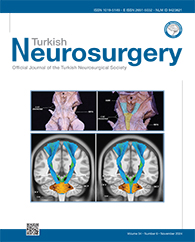2Ankara University, Faculty of Medicine, Department of Radiology, Ankara, Türkiye
3Recep Tayyip Erdogan University, Faculty of Medicine, Department of Radiology, Rize, Türkiye
4Basaksehir Cam ve Sakura Hospital, Department of Radiology, Istanbul, Türkiye DOI : 10.5137/1019-5149.JTN.44188-23.3 AIM: To retrospectively evaluate the cranial magnetic resonance imaging (MRI) features and determine the incidence of intracranial arachnoid cysts (ACs) based on sex, age, location, size, affected side, Galassi type, and their association with hydrocephalus, mega cisterna magna (MCM), bone erosion, and midline brain shift in 15,108 patients during outpatient headache evaluations.
MATERIAL and METHODS: Between 2012 and 2022, cranial MRI scans of 15,108 adult patients aged 20?70 years undergoing outpatient evaluations for headaches were retrospectively reviewed to analyze the features of ACs detected incidentally. Patients who had previously undergone a craniotomy or craniectomy were excluded from the study.
RESULTS: The relationship between the location of AC and hydrocephalus did not show statistically significant differences between the supratentorial and infratentorial subgroups (p=0.557). The relationship between the location of AC and MCM showed statistically significant differences between the two groups (p=0.008). MCMs occur more commonly in supratentorial ACs than in infratentorial ACs.
CONCLUSION: The increased use of MRI in assessing patients with headaches has resulted in an increased detection of ACs. Although managing asymptomatic lesions typically involves periodic follow-ups, symptomatic lesions can sometimes require surgical treatment, such as AC fenestration, cyst aspiration, endoscopic shunt placement, or microneurosurgery.
Keywords : Arachnoid cyst, Mega cysterna magna, Robotic surgery, Cystoperitoneal shunt




